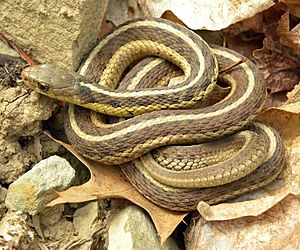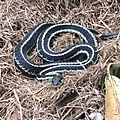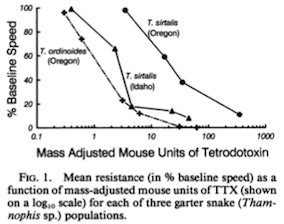Common garter snake facts for kids
Quick facts for kids Common garter snake |
|
|---|---|
 |
|
| Eastern garter snake (Thamnophis sirtalis sirtalis) |
|
| Conservation status | |
| Scientific classification | |
| Genus: |
Thamnophis
|
| Species: |
sirtalis
|
| Subspecies | |
|
12 sspp., see text |
|
 |
|
| Range of T. s. pickeringii
Range of T. s. fitchi Range of T. s. concinnus Range of T. s. infernalis Range of T. s. tetrataenia Range of T. s. parietalis Range of T. s. dorsalis Range of T. s. annectens Range of T. s. sirtalis Range of T. s. pallidulus Range of T. s. semifasciatus Range of T. s. similis Range of Intergrade zones |
|
| Synonyms | |
|
|
The common garter snake (Thamnophis sirtalis) is a type of snake found all over North America. These snakes often have yellow stripes on a black, brown, or green body. They usually grow to be about 55 cm (22 inches) long. Some can reach up to 137 cm (54 inches). They weigh around 150 grams (5.3 ounces). The common garter snake is the official state reptile of Massachusetts.
Contents
About Garter Snakes
Naming the Snakes
The name fitchi honors an American snake expert named Henry Sheldon Fitch. The name pickeringii honors an American nature expert named Charles E. Pickering.
Different Kinds of Garter Snakes
Scientists currently recognize 12 different kinds, or subspecies, of common garter snakes. They are listed here by the year they were first described:
| Image | Subspecies | Where They Live |
|---|---|---|
 |
T. s. sirtalis (Linnaeus, 1758) – eastern garter snake | Eastern North America |
 |
T. s. parietalis (Say, 1823) – red-sided garter snake | From Fort Smith, Northwest Territories, down to the Oklahoma-Texas border |
 |
T. s. infernalis (Blainville, 1835) – California red-sided garter snake | California coast |
 |
T. s. concinnus (Hallowell, 1852) – red-spotted garter snake | Northwestern Oregon and southwestern Washington |
| T. s. dorsalis (Baird & Girard, 1853) – New Mexico garter snake | Mexico and southern New Mexico | |
 |
T. s. pickeringii (Baird & Girard, 1853) – Puget Sound garter snake | Northwestern Washington, Vancouver Island, and southwestern British Columbia |
 |
T. s. tetrataenia (Cope, 1875) – San Francisco garter snake (endangered) | San Mateo County, California |
 |
T. s. semifasciatus (Cope, 1892) – Chicago garter snake | Chicago, Illinois |
 |
T. s. pallidulus Allen, 1899 – maritime garter snake | Northeastern New England, Quebec, and the Maritime provinces |
 |
T. s. annectens B.C. Brown, 1950 – Texas garter snake | Texas, Oklahoma, and Kansas |
 |
T. s. fitchi Fox, 1951 – valley garter snake | Rocky Mountains and interior ranges |
 |
T. s. similis Rossman, 1965 – blue-striped garter snake | Northwestern peninsular Florida |
Snake Features
Common garter snakes are usually thin. Most do not grow longer than about 1.2 meters (4 feet). They often have stripes running along their bodies. These stripes can be many different colors. Garter snakes come in green, blue, yellow, gold, red, orange, brown, and black.
Is Their Bite Dangerous?
Garter snakes have a mild venom in their saliva. This venom can be harmful to small animals they hunt. For humans, a bite is not dangerous. If a garter snake bites you, it might cause a little itching or swelling. However, they usually do not break the skin. Before biting, garter snakes often release a stinky fluid from special glands. This fluid is called "musk" and helps them scare away predators.
Garter snakes can eat animals that are poisonous to other creatures. For example, they can eat American toads and rough-skinned newts. These newts produce a strong poison that could even harm a human. Garter snakes are resistant to this poison. They can even store the poison from their prey in their own bodies. This makes the garter snake poisonous to animals that try to eat them.
Garter snakes use their resistance to poison for both hunting and defense. Their mild venom helps them catch small prey like mice. Their ability to handle poisons from newts helps protect them from predators. Snakes that live where these poisonous newts are found are more resistant to the poison. This shows how animals can evolve to deal with threats in their environment.
However, being resistant to poison has a cost. Eating the poison can make the snake slower. It might even make them unable to move for a while. It can also affect their body temperature control. This is like an "arms race" between the snakes and the newts. Snakes that live far from poisonous newts have less resistance. This is because the resistance can actually be a disadvantage if there's no poison around.
Where Garter Snakes Live
Common garter snakes can live in many different places. You can find them in forests, fields, and prairies. They also live near water, like streams, wetlands, and ponds. They are often found close to water sources.
These snakes live across a huge area. They can be found as far south as Florida in the United States. They also live as far north as the Northwest Territories in Canada. They can live from sea level all the way up into the mountains.
How Garter Snakes Behave
Common garter snakes are active during the day. In summer, they are most active in the morning and late afternoon. When it's cooler, they only come out during the warmest parts of the day.
In warm southern areas, they are active all year. In colder places, they sleep together in dens. Sometimes, many snakes share one den. On warm winter days, some snakes might come out of their dens to warm up in the sun.
How They Avoid Danger
Garter snakes have many ways to protect themselves from predators. They can change their body shape in different ways. These postures show if the snake is ready to run, fight, or hide. How they react also depends on things like their body temperature and if they are male or female.
A warmer garter snake is more likely to run away from danger. A cooler snake might stay still or try to attack. Male garter snakes also tend to run away more often. Snakes that are more aggressive in their defense are often faster and have more energy.
When a garter snake first sees a predator, it might try to bluff. If you gently touch a snake in a lab, it might act aggressive at first. But then it might become calm. This is because they usually don't want to attack something much bigger than them. Garter snakes rely on their colors to blend in. They will freeze until they think they are seen. Then, they try to sneak away.
Young garter snakes might act differently if they have just eaten. Snakes with full stomachs are more likely to strike at a threat. This is because a big meal can make them less able to move quickly.
Where a snake is attacked also affects its reaction. Many birds and mammals try to attack a snake's head. If attacked near the head, garter snakes often hide their heads. They might also wave their tails back and forth. If attacked in the middle of their body, they are more likely to run away. They might also open their mouths as a warning.
Age also plays a role in how garter snakes react. Adult snakes can be active for much longer than young snakes. Young snakes can only be active for a few minutes. Adult snakes can be active for up to 25 minutes. This extra energy helps adult snakes escape predators. It also affects where young snakes can live and what they can eat.
Having Babies
Female garter snakes give birth to live young. They can have 12 to 40 babies at a time. This usually happens between July and October.
What Garter Snakes Eat
Garter snakes mostly eat amphibians like frogs and salamanders. They also eat earthworms, leeches, slugs, snails, insects, crayfish, fish, lizards, other snakes, small birds, and rodents. They are good at catching fast-moving prey like fish and tadpoles.
Who Eats Garter Snakes?
Many animals prey on common garter snakes. These include large fish like bass and catfish. Other predators are American bullfrogs, common snapping turtles, larger snakes, hawks, raccoons, foxes, wild turkeys, and even pet cats and dogs.
Protecting Garter Snakes
The common garter snake is not considered to be in danger. This is because they are found in many places and have a large population. However, things like water pollution and new buildings can threaten them.
One specific type, the San Francisco garter snake (T. s. tetrataenia), is very rare. It only lives near ponds in San Mateo County, California. This subspecies has been listed as an endangered species since 1967.
Images for kids
See also
 In Spanish: Serpiente de carretera para niños
In Spanish: Serpiente de carretera para niños
- Narcisse Snake Dens







